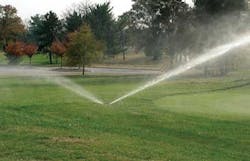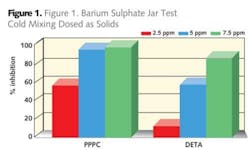By Guerry Waters
The threat of global climate change has galvanized governments, organizations, and citizens around the world to re-imagine our lives in ways that contribute to long-term sustainability. Doing so is challenging us to reprioritize issues, rethink business plans, and reconsider the relationships between people and resources.
Nowhere is this focus on sustainability clearer than in water utilities. A decade ago, many water utility executives saw replacing an aging distribution infrastructure as their biggest challenge. Today, while that challenge remains, it has become part of a far larger issue: How can water utilities support communities and their economies as populations grow, given that fresh water supply remains level at best and in many regions is shrinking dramatically?
As drought and population growth sharpen the focus on water, utilities, environmental groups, and governments increasingly look to smart metering to help customers better understand and curb their water use; to identify leaks; and to underpin new rate and regulatory programs that respond to community water needs.
Justifying the implementation of the technology to support smart metering, however, will require cooperation and support from local and regional governments, communities, and above all, customers.
Why Should Water Utilities Move to Smart Metering?Figure 1: In many regions, it is possible to alleviate water shortages by tapping more sources. Doing so, however, requires an increased investment in water testing. Photo: National Renewables Energy Laboratory, U.S. Dept. of Energy.
Information to the Customer
Smart metering increases the information available to the customer and helps enable in-home displays. Display devices that show real-time water use help customers detect leaks. While diligent customers may, a few times a year, turn off all water and check an outside meter to ensure there is no flow, most meters are located in isolated areas that make it hard to detect new, small leaks. A conveniently located indoor monitor can help a customer notice a leak because, for instance, the reading is higher in the morning than it was at night even though in theory no one used water that day.
Prominently located displays also serve as a constant reminder about the need for water conservation. Parents can even build games for children around the readings to teach conservation habits. They also enable jurisdictions to secure customer compliance with water-use advisories or restrictions, such as weekly maximum use limits.
Preliminary investigation indicates that customers with displays are more likely to use less water. However, installing monitors at each customer site may come with a price tag water utilities find difficult to afford. As a result, many elect less expensive ways to provide consumption details, such as Web sites with individualized portals or even printouts enclosed with bills. Although surveys indicate that customers prefer the on-site display, Web portals are another effective method to link concerned customers to information on how to lower consumption and/or bills.
Information to the Utility
Smart metering also delivers valuable data to utilities. For example, utilities can use time-of-use or interval data to detect customer-premises leaks from their end. Leak detection for households is relatively simple, and utilities can use more sophisticated algorithms to identify possible leaks at commercial and industrial properties with round-the-clock water use.
Preliminary experience indicates that substantial numbers of customers will sign up for voluntary leakFigure 2: In dry regions, government officials are under increasing pressure to reduce the availability of water for golf courses and other usage that many see as optional. Photo: National Renewables Energy Laboratory, U.S. Dept. of Energy.
Further, a utility that compares daily consumption for a group of customers (such as residences on a block) with readings from a water main serving that block may be able to identify small leaks (or possibly theft) before they become too large to overlook. This could prove especially useful for drought-plagued areas where the utilities may be under heavy pressure to identify possible violations of local restrictions on, for instance, outdoor watering or non-essential water use during daylight hours. Smart metering data can help them fulfill such public mandates. It can also be a major financial factor. Regulators concerned about reducing water waste may establish performance-based incentives for utilities to reduce water loss. The faster utilities can detect, size, and prioritize repairs for leaks, the better their chances to earn these incentives.
Other ways utilities can benefit from smart metering include:
- Obtaining off-cycle, “final” meter reads for customers that are moving. It is common to couple these real-time final meter reads with online or credit-card bill payment that enables utilities to collect immediately on bills that might otherwise take weeks or months to reach a relocated customer.
- Remotely disconnecting or restricting the flow of meters in regions where this is permitted.1 Remote-disconnect meters reduce the costs to send field crews to premises of customers who have either requested a disconnect or who are being disconnected (or ratcheted back) for bill nonpayment.2
- Checking meter status (“pinging the meter”) before sending a repair crew out. These checks can sometimes prevent needless field crew dispatch to customer sites.
- Ensuring that almost all bills are based on actual meter reads rather than on estimates. This reduces calls to the contact center and improves customer satisfaction.
- Helping control electricity costs for pumping water by enabling utilities to track the lowest rates and perform these activities during off-peak hours.
- Offering prepayment options to customers without the expense of special prepayment meters.3
- Providing feedback to utility staff on conservation program effectiveness, enabling them to make improvements.
So What’s the Issue?
Discussion of smart metering abounds, but many utilities hesitate when they see the large financial commitments involved and the uncertainties of customer response. Will they be able to recover the costs? Will they find themselves on the bleeding rather than leading edge of technology? Focusing just on the benefits of smart metering would be foolish. Utilities do need to look carefully at the costs and challenges they will face.
Hidden Costs of Smart Metering
Many smart metering costs are obvious. However, in addition to the costs for smart meters — two-way communications infrastructure to facilitate data sharing, a meter data management application to do the initial processing of the meter data and store it in a central repository, and the integration necessary to utilize the data — there are other less apparent costs to:
- Add technology and infrastructure to support smart meters and the major increase in data volumes.
- Modify or replace the customer information system (CIS).
- Expand or obtain software to view and analyze the usage data by various utility business and operating functions.
- Obtain or expand middleware and messaging software to reliably handle communications between applications and alerts from field devices.
- Upgrade or add hardware to store and process interval usage data.
- Educate customers about the meter replacement project, including its anticipated costs and benefits.
- Research and design new rate tariffs.
- Retrain staff to install and maintain the new meters and infrastructure.
Careful evaluation of these costs can help utilities with planning. In addition, selection of integrated applications and scalable infrastructure technology can minimize total costs.
Figure 3: Population growth and spread increase the pressure on regional reservoirs. Photo: National Renewables Energy Laboratory, U.S. Dept. of Energy.
Weighing the Costs and Benefits of Smart Metering for Water Utilities
Although there are many significant benefits possible with smart metering, it is clear that there are also challenges. Utilities must carefully consider the approach and technology requirements needed. Costs are high, and there is significant risk as well. Here are a few things to keep in mind when making the business case.
Including All Potential Benefits
Smart metering may be hard to justify if it rests solely on decreased water use. It is easier to cost-justify when it includes, for instance, the value of:
- Ensuring that all meters are recording water flow following repair of a break in a main.
- Remote programming that enables customers to use new products or services to advance community and environmental goals.
- Fewer meter readers, which lowers overhead costs.
- Remote rather than expensive and occasionally risky on-site disconnects or flow restrictions. Consider all avoided costs, including technician time and transportation costs.
- Less wasted time in attempts to pinpoint the size and source of leaks and breaks.
- Lower risk to public safety from flooded intersections or lack of service to hydrants.
- Better meter reading accuracy, resulting in fewer calls to the contact center.
- Faster theft or other loss detection.
- Lower electricity costs (for those utilities using electric pumps).
- Reduced use of chemicals currently used to treat water that is then wasted through leakage from water mains or via customer-premises leaks from pipes or fixtures.
- Longer life spans for water treatment equipment.
Valuing Conservation
For most water utilities, the leading smart metering benefit is the role it can play in conservation. As governments and citizens become increasingly conscious of the potential for water shortages, emphasis on conservation increases and conservation programs are practically an imperative. They help stabilize volume, ease wear and tear on a utility’s physical assets, and reduce use of water purification chemicals, thus cutting costs while slowing environmental damage.
That does not mean, of course, that water utilities can gain approval for smart metering merely by invoking conservation. It does mean, however, that regulators are more likely to value conservation as a non-monetized benefit of smart metering.
Conclusion
A new generation of water utility leaders is emerging in response to communities’ increasing concerns. They articulate a new vision: sustainable water distribution systems that minimize cost, maximize safety, encourage economic development, and protect the environment while delivering reliable service.
There is every reason to believe that smart metering will replace most of today’s metering approaches within the foreseeable future. At today’s prices, many utilities are constructing conservative business cases that foresee a relatively short payback period for smart metering investments. Rapidly falling prices and the multiple advantages to both customers and utilities should make the systems even more compelling.
A strong technology infrastructure can help water utilities realize their new vision. But creating such an infrastructure is no easy task. To respond to these challenges cost-effectively, water utilities should consider implementing an integrated infrastructure of business software applications. With a solid applications infrastructure — especially one optimized for water utility business processes — they maximize their opportunities to meet their most important goals: matching water supply and demand at affordable prices that preserve communities and foster economic growth.
About the Author
Guerry Waters is the vice president of industry strategy for Oracle Utilities. He joined Oracle Utilities in 2006 when Oracle acquired SPL WorldGroup, a company he joined in 2000. Previous positions include Vice President of Energy Information Strategy at META Group (now Gartner) and CTO and Director of Technology Strategy and Engineering at Southern Company. He focuses on IT strategies that help utilities meet their goals amidst changing customer demands, regulations, and market structures.
Notes
- Disconnection is not universally practiced. In the UK, for instance, the Water Act 1991 and NRSWA Section 79/80 prohibit disconnection or flow restriction for bill non-payment.
- Note that, unlike smart meters for electricity, smart water meters must be equipped with a separate device in order to control water flow. This increases the total cost of a water smart meter.
- For an explanation of how such programs work, see the Oracle Utilities white paper “Serve Prepaid Customers Without Prepayment Meters.”






